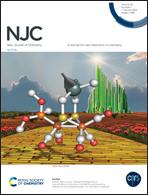Preparation of microsphere-added aerogels and exploration of their adsorption properties†
Abstract
The wastewater from industries contributes largely to water pollution, and its treatment is always complicated, expensive and inefficient. In this study, polyaniline/silica microsphere/graphene aerogels (PANI/SiO2/GA) were prepared in situ by polymerization, and the nanocomposites were utilized as effective adsorbents to eliminate dyes and oils. The structure, morphology and composition of the nanocomposites were characterized by X-ray diffraction (XRD), scanning electron microscopy (SEM), Fourier transform infrared (FTIR) spectroscopy and transmission electron microscopy (TEM). The adsorption capability of PANI/SiO2/GA to methylene blue (MB) and malachite green (MG) was studied using various experimental parameters such as the initial concentration of dyes, contact time, pH and adsorbent dosage. The results indicate that the adsorption process is relatively rapid, which takes only a few minutes, the adsorption capacity of MB and MG is as high as 140 mg g−1 and 160 mg g−1, respectively, and most kinds of the cationic dyes could be adsorbed from water. In the oil absorption experiment, PANI/SiO2/GA could adsorb many kinds of oils, as it has excellent adsorption capacity; it is easy to perform adsorption–desorption, and the times of adsorbent reuse to adsorption is more than 7 times.



 Please wait while we load your content...
Please wait while we load your content...